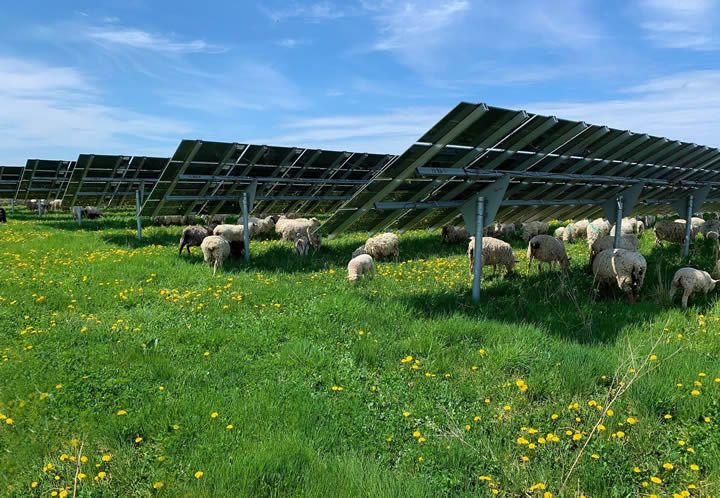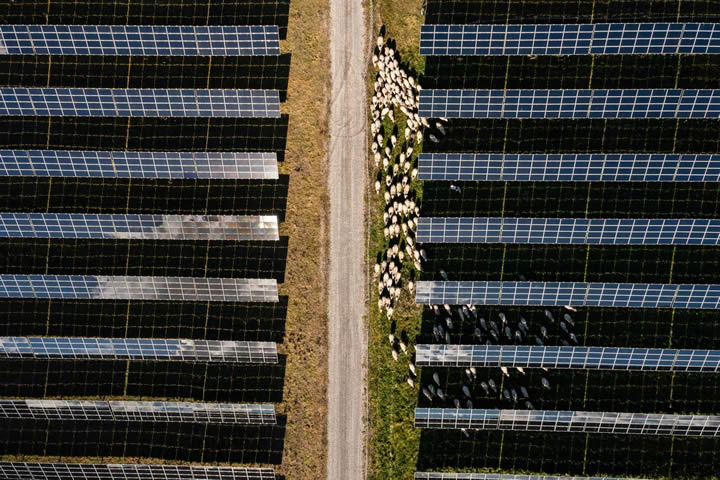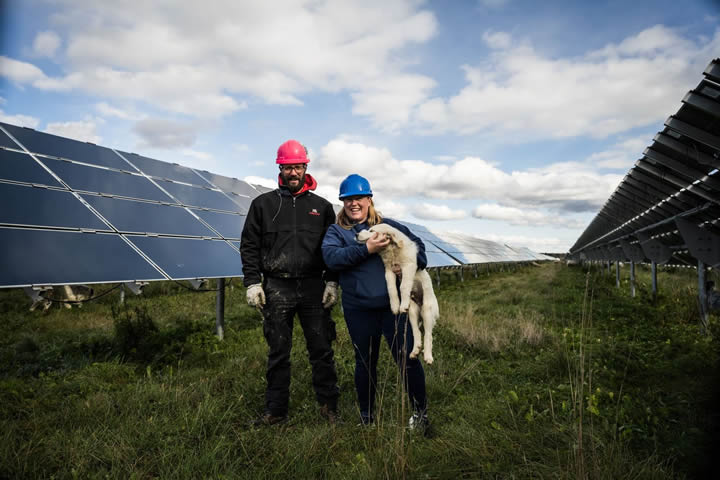The success of “solar grazing” programs at Arnprior and other facilities across Canada and the U.S. has garnered attention from landowners, sheep farmers and solar developers alike.
 Solar + Sheep = Success! Renewable ways to live off the land
Solar + Sheep = Success! Renewable ways to live off the land

Case Study from | EDF Renewables
Farmers make their living off their land and livestock and are keenly attuned to the need to maintain or enhance the productivity of their resources. They are also deeply committed to being good caretakers of their land and preserving it for future generations.
Chris Moore and Lyndsey Smith are no exception. Both grew up in agricultural families that raised animals and production crops. When they first met in 2016, they each had small flocks of sheep – Chris was farming land within the city limits of Ottawa, Ontario that his grandparents first farmed as a dairy beginning in the 1960s, and Lyndsey was leasing pasture in the area.
In 2017 they combined their flocks to form Shady Creek Lamb Co. but were still far short of the 400-500 animals needed to support a full-time sheep farming enterprise. They wanted to grow their business but knew that expanding would likely require a lot of capital.
“Initially, we figured we had two options,” Chris explains. “We could invest hundreds of thousands of dollars into building a barn and switch to an indoor operation – but we are really committed to pasture grazing our sheep, so that wasn’t very appealing to us.”
“Alternatively, we could invest hundreds of thousands of dollars into purchasing additional land so we could continue to graze our flocks on pasture,” Lyndsey says.
“At almost 2,800 square kilometers (1,000 square miles), Ottawa is one of the largest cities in Canada, and even though a lot of the area within city limits is rural farmland, property is very expensive. Taking on that much debt was daunting, so we put our heads together to think of what else we could do.”
EDF Renewable’s Arnprior Solar is a 23.4 MW facility just a few miles away from Chris’ farm. “I’d driven by it every day for years. Finally, in the summer of 2017 Lyndsey cold-called them to ask if we could talk about grazing our sheep there,” Chris remembers.
Unbeknownst to Chris and Lyndsey, EDF Renewables (EDFR) had already started discussing grazing sheep on another solar site in Ontario and was interested in exploring this approach to vegetation management.
Unlike solar projects in the desert southwest, vegetation control is essential in areas that get a lot of rainfall, because if excessive plant growth covers or shades the solar panels, the amount of clean energy produced drops significantly.
“We had a virtual meeting with EDFR and pitched a 30-day pilot project for the fall of 2017, which went very well,” Lyndsey recalls. “In the spring of 2018, we started our first vegetation abatement contract at Arnprior, and the rest is history! We’ve been able to grow our flock every year, and in 2021, we took on a second site for EDFR.”
After their first one-year contract in 2018, the partners entered three-year contracts. Now in entering their second year of the second three-year partnership, the Shady Creek Lamb Company has tripled the size of its flock.
The success of “solar grazing” programs at Arnprior and other facilities across Canada and the U.S. has garnered attention from landowners, sheep farmers and solar developers alike.
“Solar grazing creates ‘win-win-win’ situations,” observes Kevin Campbell, Director, Development with EDFR. “Farmers benefit from the increased access to pasture grazing for their sheep, and landowners benefit from the natural improvements to soil quality that occur as a result of grazing, which include reduced erosion, weed control, improved soil health, and greater carbon sequestration due to the land not being tilled.”
“Perhaps most importantly, farming communities in general benefit from the preservation of farmland and open space,” Kevin continues. “Unlike housing or other forms of commercial land development, solar is fully reversible – and as noted, if sheep are grazing the project, it may actually improve soil quality.”
EDFR is developing several solar projects in New York State and talking to landowners about the benefits of hosting panels, and grazing sheep, on their property. “The New York Department of Agriculture and Markets’ energy guidelines establish a framework for the protection of topsoil and to remediate for soil compression, essentially ensuring that fertile land prior to construction will remain fertile post construction. After the operating life of the project, components are removed and the site is remediated,” Kevin elaborates.
Another example of the protection of topsoil is with the storm water pollution prevention plan (SWPPP, pronounced “swip”) permits require that erosion and stormwater runoff be managed. By maintaining dense groundcover on the land year-round, solar projects ensure that rainwater is absorbed on the site.
In fact, a University of Arizona study showed that because solar panels provide shade, there’s less evaporation and better groundwater recharge where they’re installed.

“It’s very important to us that we act as good stewards of the land,” Kevin says. “Construction does require that we build some access roads and install foundations for equipment like the solar panels and the transformers, but once construction is finished, between 95-98% of the land is usually revegetated.”
Solar projects are typically designed to have 30-year lifespans, at the end of which landowners and project developers can evaluate if it makes sense to continue. “All of our project agreements include a decommissioning plan that commits to return the land to farming,” Kevin notes.
At Arnprior, the sheep graze around and under the panels, and the sheep are particularly helpful at eating young trees and climbing vines. They use the panels for shelter and shade, and like to ruminate under the panels, which results in any uneaten vegetation being trampled down.
“During the heat of the summer, I'd much prefer the flock be at the solar site than at home because there's shade everywhere, and it is noticeably cooler.” Lyndsey says.
Protecting the sheep from predators is a top priority for Chris and Lyndsey, and they rely on their livestock guardian dogs, mixed breeds of dogs with history of evolving with sheep, to play a crucial role in keeping the flock safe from coyotes and other predators. “Our dogs all come from working parents, and their instincts are amazing. It’s Incredible to watch how well they bond with their sheep, how they alert, and how they flock the sheep together.”

With hundreds of sheep as well as guardian dogs to manage, Chris and Lyndsey keep busy – especially in spring when the lambs are born. “Someone checks on the sheep and the dogs at least once a day, although during lambing, we check on them much more frequently,” Lyndsey says.
The sheep paddocks are created with movable electric fencing powered by solar panels, which are installed on a trailer that also provides water for the sheep and the dogs. During the day, the solar panels charge a marine battery that keeps the fencing energized overnight.
“We also have to move their paddocks every few days,” Chris explains. “We could just turn the sheep loose throughout the full site, but that wouldn’t be as effective in terms of vegetation management, because they’ll tend to overgraze some areas and under-graze others. By keeping them in pens that are about two acres in size, we find that they’ll eat about a third of the vegetation, trample another third, and leave a third – which is important, because part of not letting weeds take over is ensuring that they have competition from other plants. If needed, we’ll go in and cut down any noxious weeds the sheep don’t eat so they don’t go to seed.”
Chris and Lyndsey are enthusiastic proponents of solar grazing. “There are just so many positives to it. We’ve seen what it can mean for building our business, we’ve seen what it can mean for ecosystems and habitat, and we’ve seen what it can mean in terms of boosting productivity per acre,” Lyndsey says.
“I’ve heard folks say that using farmland for solar panels is unproductive, but I just don’t agree,” says Lyndsey. “In some cases, it may be true that a cash crop is the way to generate the most income from a piece of land. But in many places, particularly with marginal or depleted land, having solar panels and pasture means that you’re producing clean energy, grazing animals for high-quality meat and wool, you can keep bees and produce organic honey, and possibly cut hay as well. That’s a lot of economic value when you add it all up.”
The economic benefits of Chris and Lyndsey's expanded flock extend beyond their own farm. With their flock tripled, they now have an increased need for veterinary services, larger orders with their feed and equipment suppliers, and sheep shearers. This increased demand for services and supplies creates a ripple effect that benefits the entire agricultural community.
Grazing their flock at EDRF’s solar facilities has helped Shady Creek Lamb Co. grow and build its reputation in Ottawa and beyond. Its customers include restaurants that feature locally sourced grass-fed lamb on their menus, as well as individual customers who want to stock their freezers with lamb or want muton for sausage or pet food. “In the summer and fall, we also do a brisk trade at local farmers markets, which is fun and provides a nice way to connect with the community,” Lyndsey says.
The growth has come with challenges. Chris and Lyndsey had to expand flock quickly to effectively graze the site, and since sheep do not graze during the winter in northernly climates “That comes with the question where do I put them and how do we feed them all winter?” Lyndsey says. “From a farmer’s perspective, we have to figure out our production system and how to care for them in the winter.”
The sheep are typically on site from late April through late October or early November. In 2022, Chris and Lyndsey began moving their sheep from Arnprior to neighboring landowners who have begun to use cover crops to preserve soil over the winter months.
“We have found that by adding the cover crop grazing piece, which can add two to four months of grazing in the fall, it definitely changes the dynamic of how much winter feed is needed and how many sheep you can effectively graze in in a season,” Lyndsey says.
“The support from EDFR has been amazing,” Chris adds. “They’ve been on site from Day 1. They’ve gone through the growing pains with us and have been very understanding. We worked together to develop safety protocols for our employees and theirs, and now we’re at the point where we’re ready to share our knowledge and experience with others.”
“Like many farmers, our first reaction when we saw solar panels was to think that farmland was being eaten up,” Chris remembers. “However, we soon realized that a solar farm can still be farmed, we just have to farm it differently. We’re not taking farmland out of production; we’re just changing how we manage it.”
“I’m stunned by the transformation in the health of the habitat and ecosystems at Arnprior over the course of just a few years,” Lyndsey chimes in. “It’s full of insects and birds, and the bees kept on the site do really well because the area is free of pesticides and herbicides. In addition, the fact that we are constantly moving the sheep around means there’s always stuff that’s blooming and growing – unlike when you mow a site, which cuts everything at the same time. If this land were being used for cash crops like grain or corn, it would be very different.”
“Having the sheep at Arnprior has been just great,” Kevin observes. “Prior to their arrival, the site had to burn fuel to mow around and between the panels, and they had to do a lot of work to control vegetation under the panels, where it would otherwise wrap around the cabling and other equipment. We haven’t completely eliminated fossil fuel use at the site, but it’s been dramatically reduced.”
“I really believe that solar is a great way to protect farmland and preserve it for future generations,” Kevin reflects. “Landowners are compensated on a dollar-per-acre basis, so they generally want us to use as much of their land as we can, but we work closely with them to understand and identify any exclusion areas that aren’t to be touched, such as wooded areas or land they want set aside for other purposes.”
A 100-megawatt solar project would typically require about 1,000 acres of land, about half of which would be used for panels. In many cases, this means projects are not contiguous, and may involve a few – or several – landowners.
“In addition to the meaningful environmental benefits, solar grazing offers a way to make the land even more productive,” Kevin says. “Beyond helping existing sheep farmers to grow their flocks, it also creates an entry point for people who might want to start farming, but don’t have land or access to capital. In the future, we may even see community-based approaches that further lower the barriers to entry.”
DID YOU KNOW?
It’s been estimated that you can get 30 times more energy from an acre of land used for solar than from an acre of land used to grow corn for ethanol. Stated differently, you could drive an electric vehicle 70 times farther using the electricity produced by solar panels than you could if the same amount of land were used to grow corn for ethanol.
ABOUT EDF RENEWABLES
EDF Renewables North America is a market-leading independent power producer and service provider with more than 35 years of expertise in renewable energy. The Company delivers grid-scale power: wind (onshore and offshore), solar photovoltaic, and storage projects; distribution-scale power: solar and storage; asset optimization: technical, operational, and commercial expertise to maximize performance of generating projects, and onsite solutions, through the Company’s PowerFlex subsidiary, offering a full suite of onsite energy solutions for commercial and industrial customers: solar, storage, EV charging, energy management systems, and microgrids. EDF Renewables North America is a subsidiary of EDF Renewables, the dedicated renewable energy affiliate of the EDF Group. For more information visit: www.edf-re.com.
The content & opinions in this article are the author’s and do not necessarily represent the views of AgriTechTomorrow
Comments (0)
This post does not have any comments. Be the first to leave a comment below.
Featured Product

